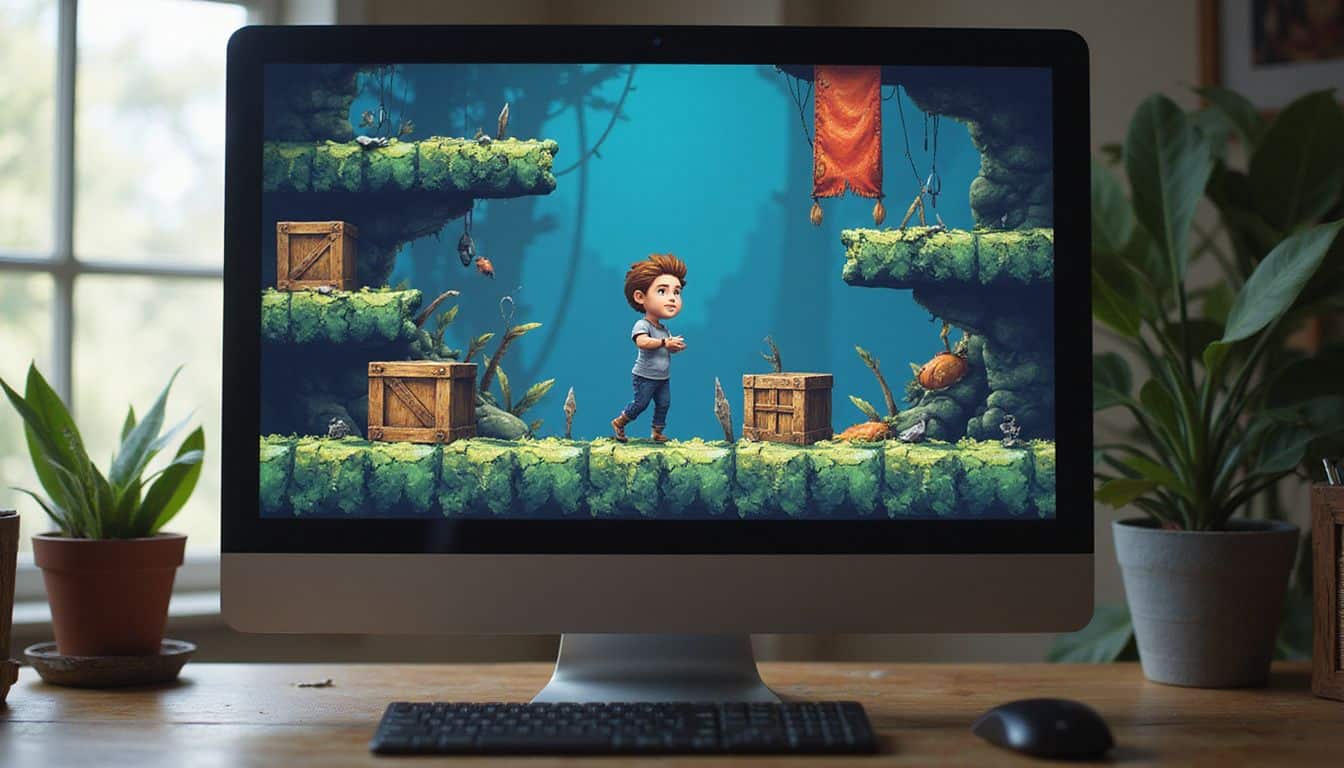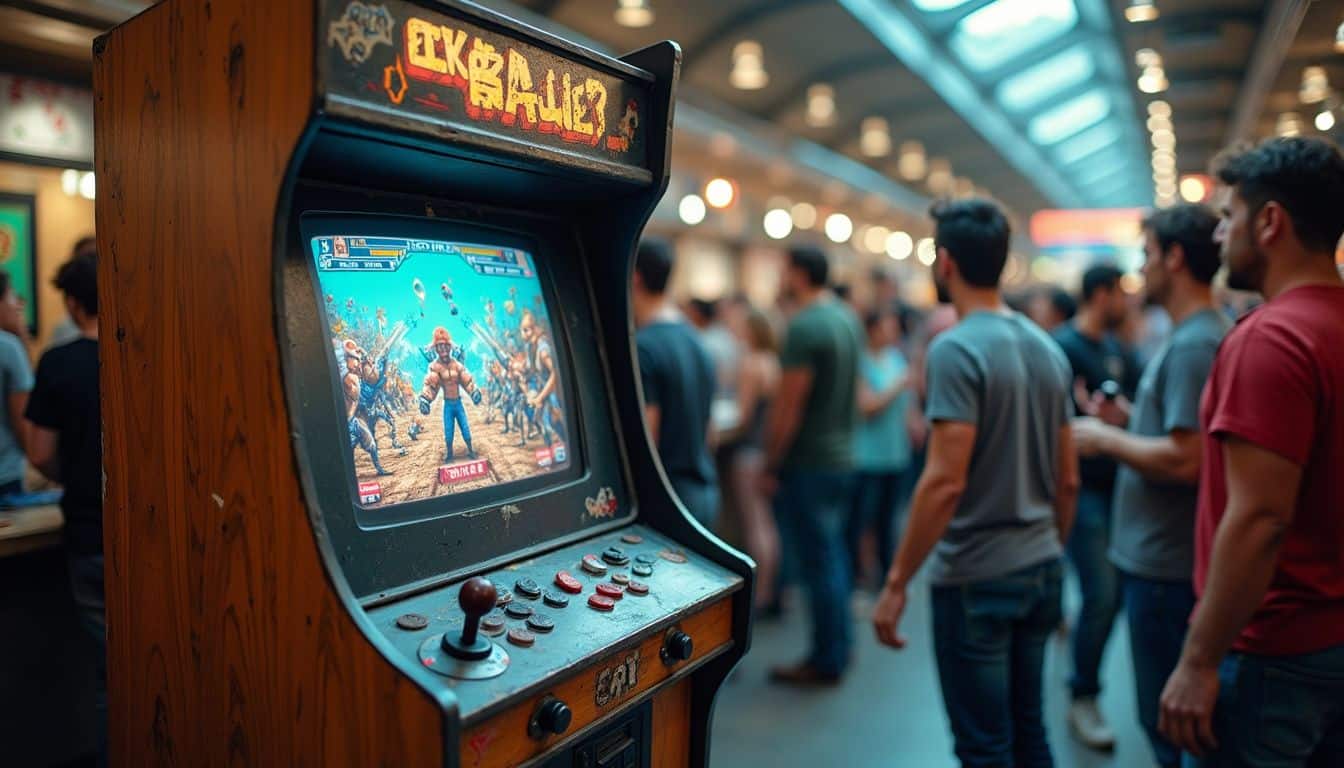Gamers often feel lost when choosing what to play next, unsure which interesting game genres match their mood or skill level. The global gaming audience now exceeds 3 billion players across PC, console, and mobile platforms.
This guide breaks down 15 essential video game genres with clear explanations of what makes each type special, from action-packed shooter games to brain-teasing puzzle games. You’ll discover your next favorite gaming experience.
Key Takeaways
Over 3 billion gamers worldwide play across PC, console, and mobile platforms, creating a massive global gaming audience.
Action games like platformers dominated 25-33% of console releases in the late 1980s gaming boom period.
Shooter games captured 14.1% of PC gaming revenues in 2024, with 63.2% of players aged 16-24.
Visual novels comprise about 70% of released PC games in East Asia, particularly Japan’s gaming market.
Auto chess games gained over eight million players within months, showing rapid growth in strategic gaming genres.
Table of Contents
Action Games: Different Types of Fast-Paced Gameplay

Action games pump adrenaline through your veins with lightning-fast reflexes, split-second decisions, and heart-pounding combat sequences. These titles demand quick-thinking and precise timing, making every moment feel intense and engaging… and speaking of intense action, I’ve found myself drawn to the action of online casinos accepting Mastercard, which reminds me of classic action games in some ways.
What are Platformer Games and Why Are They Popular?

Platformer games focus on moving characters across uneven terrain and obstacles. These action games originated in the 1980s with titles like Space Panic, Donkey Kong, and Super Mario Bros.
Players jump, climb, and run through levels filled with gaps, enemies, and challenges. The genre exploded in popularity during the late 1980s, making up 25-33% of all console game releases.
Platformers teach us that every obstacle is just another chance to jump higher.
These games remain popular because they offer simple controls with deep gameplay mechanics. Modern variations include endless runner games and 3D platformers that expand the classic formula.
The genre connects with players through precise timing, skill-based challenges, and satisfying movement systems. Platformers provide immediate feedback, clear goals, and that “just one more try” feeling that keeps gamers engaged.
This appeal ties into understanding why people are drawn to video games in the first place.
How Do Shooter Games Work and What Are Their Features?

Platformer games focus on jumping and movement, while shooter games center on combat with ranged weapons. These action games task players with defeating enemies using firearms, grenades, and other projectile weapons.
Players aim, fire, and take cover as they move through various environments filled with hostile targets.
Shooter games captured 14.1% of PC gaming revenues in 2024, making them a major force in the gaming industry. First-person shooters like Helldivers II, Valorant, and Counter-Strike 2 attract 63.2% of gamers aged 16-24.
These games feature weapon customization, multiplayer modes, and competitive rankings. Popular titles include military shooters, hero shooters, and third-person shooter variants that offer different camera perspectives and gameplay mechanics.
What Defines Stealth Action Games?

While shooter games focus on direct combat and firepower, stealth action games take a completely different approach. These games prioritize avoiding detection over direct confrontation, making sneaking and careful planning the core gameplay elements.
Stealth action games challenge players to move through levels without being spotted by enemies. Notable examples include 2D titles like Metal Gear and 3D titles like Metal Gear Solid, which helped define the genre.
Players must use shadows, distractions, and timing to complete objectives while staying hidden from guards and security systems.
What Are Beat ‘Em Up Games and How Are They Played?

Stealth games focus on avoiding enemies, but beat ’em up games take the opposite approach. Beat ’em up games involve hand-to-hand combat against multiple opponents at once. Players control characters who fight through waves of enemies using punches, kicks, and special moves.
These action games put you in direct confrontations where stealth becomes impossible.
Classic beat ’em up titles like Kung-Fu Master, Double Dragon, and Final Fight defined this genre in the 1980s and 1990s. Players move from left to right across side-scrolling levels, defeating groups of enemies before facing powerful bosses.
Most games allow 2 players to team up and fight together. Combat systems focus on timing attacks, grabbing enemies, and using weapons found on the ground. Health meters show damage taken, and players lose lives after taking too much punishment.
Beat ’em ups are all about the satisfaction of clearing a screen full of bad guys with your fists. – Arcade Gaming Magazine
Adventure Games: Exploring Story-Driven Experiences

Adventure games put story first, letting players explore rich narratives through puzzles, character interactions, and immersive worlds… and there’s way more depth to discover in each subgenre.
What Are Point-and-Click Adventures?
Point-and-click adventures let players control characters by clicking on screen objects, items, and locations. These adventure games focus on story-driven puzzles where players collect items, talk to characters, and solve mysteries through mouse clicks.
The genre peaked in popularity from the late 1980s to mid-1990s with classic titles that defined interactive storytelling.
Players navigate through detailed environments by pointing and clicking rather than using complex controls. Popular examples include the Monkey Island series, Day of the Tentacle, and modern titles like Broken Age.
In East Asia, particularly Japan, adventure games comprise about 70% of released PC games as visual novels, showing how this genre evolved differently across regions. These games combine inventory management, dialogue trees, and logical problem-solving to create engaging narrative experiences.
How Do Visual Novels Combine Storytelling and Gameplay?
Visual novels emphasize storytelling and player agency through choice-driven narratives that shape the entire experience. Players make decisions at key story moments, which directly affect character relationships, plot development, and multiple endings.
Rich character development unfolds through dialogue trees, internal monologues, and branching conversations that reveal personality depths. Games like Ace Attorney demonstrate how visual novels blend narrative choices with puzzle-solving elements, creating interactive storytelling experiences.
Choice-driven narratives give players control over story outcomes while maintaining strong narrative focus. Multiple endings reward different decision paths, encouraging replay value and exploration of alternative storylines.
The gameplay mechanics center on reading, decision-making, and character interaction rather than traditional action elements. This approach creates immersive experiences where story progression depends entirely on player choices, making each playthrough unique based on selected dialogue options and narrative branches.
What Makes Interactive Movie Adventures Unique?
Visual novels focus on text-based storytelling, but interactive movie adventures take a different approach. These games blend film-quality visuals with player choices to create cinematic experiences that feel like controlling a movie.
Interactive movie adventures offer higher production values than most video game genres. Titles like *Life is Strange*, *Myst*, and *Grim Fandango* showcase film-quality visuals and sound design that rivals Hollywood productions.
Player choices create dynamic storytelling experiences, leading to multiple endings based on decisions made throughout the game. The integration of cinematic elements and gameplay offers a unique narrative experience that emphasizes narrative depth over reflex challenges.
These games incorporate various styles, including adventure, horror, and drama, which broadens their appeal to different audiences.
Interactive movie adventures bridge the gap between passive entertainment and active participation, creating experiences where every choice shapes the story’s outcome.
Role-Playing Games (RPGs): Varieties of Character-Driven Gameplay

RPGs put you in the shoes of characters you build, level up, and guide through epic adventures. These role-playing games come in many flavors… from action-packed combat systems to turn-based battles, each offering unique ways to develop your hero’s story and abilities.
What Are Action RPGs and How Do They Play?
Action RPGs blend fast combat with character development systems. Players control heroes in real-time battles, swinging swords, casting spells, and dodging attacks while building stats and collecting loot.
These games mix the excitement of action games with the depth of role-playing games.
Diablo IV combines dynamic combat and RPG character customization, letting players slash through demons while upgrading abilities and gear. Action role-playing games feature level progression, skill trees, and equipment upgrades that make characters stronger.
Players explore dungeons, complete quests, and fight bosses to earn experience points and rare items that boost their power.
What Are Japanese RPGs (JRPGs) Known For?
While action RPGs focus on real-time combat, Japanese RPGs take a different approach to role-playing video games. JRPGs emphasize turn-based combat systems, deep storytelling, and character development over fast-paced action.
Final Fantasy XVI and Persona 5 stand out as leading JRPGs that showcase the genre’s signature elements. These games feature elaborate storylines, memorable characters, and strategic battle systems that require careful planning.
JRPGs typically include anime-inspired art styles, epic soundtracks, and complex narratives that span dozens of hours, making them perfect for players who enjoy immersive storytelling experiences.
How Do Roguelike RPGs Challenge Players?
Roguelike RPGs create intense pressure through permanent character death, forcing players to restart completely after each failure. Hades demonstrates this mechanic perfectly, combining procedural generation with permadeath to ensure no two runs feel identical.
Players must adapt quickly to randomly generated dungeons, enemies, and loot drops that shift with every attempt.
Death is not the opposite of life, but a part of it. – Haruki Murakami
These games demand strategic thinking and resource management since mistakes carry permanent consequences. Players face high-stakes decisions about equipment, skills, and exploration routes because one wrong move ends their progress entirely.
The procedural generation keeps veterans on their toes, preventing memorization of layouts or enemy patterns that would make subsequent runs easier.
What Features Define Sandbox RPGs?
Sandbox RPGs give players complete freedom to shape their own adventures and stories. These games combine traditional role-playing elements with open-world exploration, letting you choose your path without strict mission structures.
Grand Theft Auto V, Elden Ring, and Minecraft stand as prime examples of this genre, each offering vast worlds where players create their own experiences. Character progression systems work alongside unrestricted gameplay, allowing you to develop skills and abilities that match your playstyle.
Open worlds serve as the foundation for sandbox RPGs, providing massive environments to explore at your own pace. Players can ignore main storylines entirely, focusing instead on side quests, crafting systems, or building mechanics.
These games feature emergent gameplay where your choices create unique situations and outcomes. The genre blends action RPG combat with creative freedom, giving you tools to modify environments, construct bases, or interact with game systems in unexpected ways.
Strategy Games: Different Methods of Tactical Thinking

Strategy games make you think like a general, forcing you to plan moves, manage resources, and outsmart opponents through careful tactics… and there’s way more depth to discover in these brain-bending genres.
What Is Real-Time Strategy (RTS) Gameplay?
Real-time strategy (RTS) gameplay puts players in control of armies, resources, and bases while action unfolds continuously. Players build structures, gather materials, train units, and battle enemies all at the same time, without waiting for turns.
RTS games demand quick thinking and multitasking skills as you manage economy, military forces, and tactical decisions simultaneously.
StarCraft and Age of Empires stand as iconic real-time strategy titles that defined the genre. These strategy video games feature resource management, unit production, and combat that happens in real-time, creating intense pressure and excitement.
Players must balance expansion, defense, and offense while adapting to enemy moves instantly. Turn-based strategy games offer a different approach with their methodical, sequential gameplay style.
How Does Turn-Based Strategy (TBS) Differ from RTS?
Unlike real-time strategy gameplay, turn-based strategy games give players unlimited time to plan each move. Players take turns making decisions, creating a chess-like experience where careful thinking beats quick reflexes.
Civilization VI, XCOM 2, and Total War: Warhammer III showcase how turn-based strategy games work. Each player completes their entire turn before passing control to opponents or AI enemies.
This format lets gamers analyze every option, study unit positions, and craft detailed battle plans without time pressure.
What Are Tower Defense Games and How Are They Played?
Tower defense games challenge players to protect their base from waves of incoming enemies using strategic placement of defensive structures. Players build towers, turrets, and other defensive units along predetermined paths to stop invaders from reaching their target.
Games like Plants vs Zombies and Dungeon Defenders II showcase this genre perfectly, requiring careful resource management and tactical thinking.
Each tower type offers unique abilities, damage ranges, and upgrade paths that create complex strategic decisions. Players earn currency by defeating enemies, which they spend on new towers or upgrades to existing defenses.
The gameplay loop involves analyzing enemy weaknesses, positioning towers for maximum coverage, and adapting strategies as enemy waves become stronger and more diverse. Auto Chess games represent another evolution of strategic thinking in gaming.
What Are Auto Chess Games and Their Core Mechanics?
Auto chess games blend strategy and automation in a unique format. Players collect and position units on a grid-based board, but the battles happen automatically. Dota Auto Chess sparked this genre’s popularity, gaining over eight million players within months of its launch.
The core mechanics revolve around economy management, unit synergies, and tactical positioning.
Players earn gold each round to buy champions from a shared pool. Units combine to create stronger versions, while different character types provide powerful synergies. Notable titles include Teamfight Tactics, Dota Underlords, and Hearthstone’s Battlegrounds.
Success depends on adapting your strategy, managing resources wisely, and positioning units to counter opponents’ formations.
Simulation Games: Immersive Virtual Experiences

Simulation games let you step into virtual worlds that mirror real life… or create entirely new ones. These games focus on realistic systems, whether you’re managing a city, flying planes, or raising virtual pets.
What Are Life Simulation Games?
Life simulation games let players control virtual characters and make choices that shape their daily lives. These games focus on creativity and character development, giving players freedom to build relationships, pursue careers, and create unique stories.
The Sims stands as the most famous example, allowing players to design homes, manage personalities, and guide virtual families through life events. Stardew Valley combines farming simulation with social elements, letting players grow crops, mine resources, and form friendships with townspeople.
Players enjoy these artificial life games because they offer relaxed gameplay without time pressure or combat stress. Life simulation titles emphasize personal expression over competition, making them perfect for gamers who prefer building and nurturing over fighting.
These biological simulations create virtual worlds where every decision matters, from choosing careers to decorating homes, giving players complete control over their digital lives.
How Do Construction and Management Simulations Work?
Construction and management simulations replicate real-life scenarios through strategic planning and resource management systems. Players engage in budgeting tasks, workforce management, and project timelines that mirror actual construction challenges.
These sandbox games require effective financial management and resource allocation to succeed. Popular titles like SimCity and Cities: Skylines focus on designing and managing urban environments.
The games incorporate realistic economic systems that demand careful attention to finances and available materials.
Construction simulations serve educational purposes by fostering planning skills, critical thinking abilities, and problem-solving techniques. Many titles include tutorial modes that help new players learn core mechanics and strategic approaches.
Immersive experiences feature realistic graphics, detailed sound effects, and interactive elements that enhance gameplay. Racing games like Gran Turismo 7 and Euro truck simulator 2 share similar simulation principles but focus on vehicle operation.
These management games challenge players to balance multiple factors while achieving specific objectives within set parameters.
What Makes Vehicle Simulations Realistic?
Vehicle simulations achieve realism through precise physics engines that model real-world mechanics. Microsoft Flight Simulator and Euro Truck Simulator 2 lead the simulation genre by recreating authentic vehicle behavior, weight distribution, and environmental factors.
These racing simulators calculate tire grip, suspension movement, and aerodynamics to match actual driving conditions.
Advanced graphics engines render detailed cockpits, realistic weather systems, and accurate terrain mapping. Gran Turismo 7 showcases how vehicle simulation games capture authentic car handling through data collected from real manufacturers.
Racing simulation titles use motion capture technology, professional driver input, and extensive testing to ensure every steering input feels genuine. Sound design plays a crucial role, with engines recording actual vehicle audio to create immersive experiences that transport players into realistic driving scenarios.
Puzzle Games: Brain-Teasing Challenges

Puzzle games challenge your brain with clever problems that need smart thinking to solve… and these mental workouts come in more varieties than you might expect.
What Are Tile-Matching Games and How Do They Work?
Tile-matching games challenge players to align identical pieces in specific patterns to clear them from the board. Match-3 games are the most prevalent type, with popular examples like Candy Crush Saga and Bejeweled dominating mobile platforms.
Players swap adjacent tiles to create lines of three or more matching elements, which then disappear and award points.
These puzzle games operate on simple mechanics that create addictive gameplay loops. Gravity pulls remaining tiles downward after matches disappear, potentially creating chain reactions called cascades.
Most titles add complexity through special power-ups, limited moves, or time constraints that test strategic thinking and quick decision-making skills.
How Do Hidden Object Games Engage Players?
Hidden object games engage players through mental challenges that enhance critical thinking and problem-solving skills. Players must find specific items within cluttered scenes, creating a strong sense of achievement upon completion.
These puzzle games use immersive environments with visually appealing graphics and intricate details to foster careful observation. Themed narratives motivate players to progress through levels, enriching the overall gameplay experience.
Time limits and limited moves introduce urgency, encouraging strategic and quick thinking during each session. Regular updates and seasonal events maintain player interest by introducing new content and challenges.
The combination of visual complexity and narrative depth keeps players returning for more hidden object adventures. Logic games like these tap into our natural desire to solve mysteries and discover hidden treasures.
Next, we’ll explore what defines logic games and their key features.
What Are Logic Games and Their Key Features?
Hidden object games focus on finding items, but puzzle games branch into different types that challenge your brain in unique ways. Logic games represent a specific subgenre of puzzle games that focus on reasoning and problem-solving skills.
These games involve deduction, pattern recognition, and critical thinking, which appeals to casual and strategic gamers alike. Common formats include grid-based puzzles, riddles, and mathematical challenges that test your mental abilities.
Popular examples are Sudoku, logic grid puzzles, and nonograms like Picross that require systematic thinking. Gameplay enhances cognitive skills like logical reasoning and analytical thinking while providing a satisfying sense of achievement upon solving challenges.
Logic games deliver pure mental satisfaction without complex graphics or fast reflexes, making them perfect for gamers who enjoy thoughtful problem-solving.
What Types of Trivia Games Are Popular?
Mobile trivia apps dominate the market with games like HQ Trivia and Kahoot! bringing competitive question-and-answer formats to millions of players. These platforms feature multiple-choice and true/false question formats that keep gameplay dynamic across diverse topics like history, science, and pop culture.
Team-based trivia nights at bars and restaurants create social experiences where groups compete against each other using specialized apps or traditional formats.
Online trivia platforms offer both single-player and multiplayer experiences, with some games incorporating real-time competition between strangers worldwide. Digital trivia games often overlap with puzzle games since both require critical thinking skills and knowledge application.
Popular subjects range from general knowledge to niche topics like gaming, movies, and sports, fostering community engagement among players with shared interests. These accessible formats on mobile and online platforms have made trivia games a mainstream entertainment option that challenges players’ knowledge while building social connections.
Card games represent another major category that gamers should explore for strategic depth.
Multiplayer Online Battle Arena (MOBA) Games: Team Strategy and Hero Skills

MOBA games like League of Legends and Dota 2 pit two teams of five players against each other, with each player controlling a unique hero with special abilities. These multiplayer online battle arena titles combine real-time strategy elements with role-playing game mechanics, creating intense team-based battles where coordination and individual skill both matter.
How Does Team-Based Gameplay Function in MOBAs?
Team-based gameplay in multiplayer online battle arena games centers on 5-player squads working together to destroy the enemy base. Each player controls one hero with unique abilities, and teams must coordinate their attacks, defend key areas, and support teammates during battles.
Popular MOBA titles include League of Legends, Dota 2, and Smite, where communication and strategy determine victory more than individual skill.
Success requires players to fill specific roles like tank, damage dealer, or support character. Teams earn gold and experience by defeating enemies and neutral creatures, which lets them buy stronger items and level up their heroes.
Map control becomes crucial as teams fight for objectives like towers, jungle monsters, and special power-ups that provide strategic advantages throughout the match.
What Are Hero Abilities and Strategies in MOBA Games?
Team coordination builds the foundation for MOBA success, but individual hero abilities create the tactical depth that separates casual players from competitive champions. Each hero possesses unique abilities that directly impact team compositions and battle outcomes.
Support heroes provide healing and crowd control, tanks absorb damage and initiate fights, while damage dealers eliminate enemy champions. Players must understand their hero’s strengths and weaknesses to make informed decisions during critical moments.
Mastering hero abilities requires practice with timing, positioning, and resource management. Different hero roles define specific responsibilities that shape overall team strategy.
Communication becomes essential when coordinating ultimate abilities for maximum impact. Effective teams combine complementary hero abilities to create devastating combos that can turn entire matches around.
Players who study ability interactions gain significant advantages in team fights and objective control, making hero mastery a core requirement for MOBA success.
Battle Royale Games: Large-Scale Survival Competitions

Battle royale games drop dozens of players onto massive maps where only one survives. These games mix survival elements with intense combat, creating nail-biting matches that can last 20-30 minutes.
What Are Large-Scale Multiplayer Battles Like in Battle Royale Games?
Large-scale multiplayer battles in battle royale games drop 100 players onto massive maps where only one person or team survives. Popular battle royale games include Fortnite, Apex Legends, and Call of Duty: Warzone, which showcase this intense format perfectly.
Players start with nothing and must quickly grab weapons, armor, and supplies while fighting other competitors. Each match creates chaos as dozens of battles happen at once across the map.
These massive battles create unpredictable moments that keep players on edge. You might face three different enemy teams within minutes, or spend long periods sneaking around empty areas.
The large player count means constant action somewhere on the map, but your personal experience varies greatly. Some matches end quickly if you land in hot zones, while others let you survive until the final circles through careful positioning and smart play.
The shrinking play areas force all remaining players into smaller spaces as matches progress.
How Do Shrinking Play Areas Affect Gameplay?
Shrinking play areas create urgency, leading to closer encounters and heightened intensity in gameplay. Battle royale games like Call of Duty: Warzone and Apex Legends use this mechanic to force players together.
The contraction of the play area increases player encounters and engagement by forcing proximity. This design pushes gamers out of safe hiding spots and into direct combat situations.
Players must adapt their strategies as the available space decreases, altering gameplay dynamics completely. The shrinking mechanic encourages quicker decision-making and risk-taking as matches progress through each zone.
Final stages of matches often occur in confined spaces, intensifying pressure and stakes for players who survive. The design of shrinking zones promotes movement and stealth strategies to navigate conflicts effectively, making survival games more exciting and unpredictable for competitive gaming experiences.
Horror Games: Creating Fear and Suspense

Horror games master the art of making players sweat, jump, and question every shadow on screen. These spine-chilling experiences use clever sound design, limited visibility, and psychological tricks to keep gamers on edge throughout their terrifying adventures.
What Defines Survival Horror Games?
Survival horror games blend terror with resource management to create intense gameplay experiences. These games force players to survive with limited ammunition, health items, and tools while facing frightening enemies.
Resident Evil 4 (remake) and Silent Hill 2 showcase this genre perfectly, making players count every bullet and healing item. The scarcity creates constant tension, as players must decide whether to fight or flee from threats.
Survival horror titles focus on atmosphere over action, using dark environments, unsettling sound design, and psychological elements to build fear. Players explore creepy locations like abandoned hospitals, haunted houses, or zombie-infested towns while solving puzzles and uncovering story elements.
The gameplay emphasizes vulnerability rather than power, making encounters with monsters genuinely scary. Mastering staying calm during intense gaming moments becomes essential for success in these nerve-wracking situations.
Psychological horror games take a different approach to creating fear and suspense.
How Do Psychological Horror Games Build Tension?
Psychological horror games create tension through immersive narratives and atmospheric design that evoke fear and anxiety in players. These games use audio-visual elements and environmental storytelling to create an oppressive atmosphere that keeps players on edge.
Limited resources, such as ammunition, heighten the sense of danger and vulnerability throughout the experience. Gameplay emphasizes uncertainty and difficult choices, enhancing psychological stress as players navigate dark environments and face unknown threats.
Player choices significantly influence narratives, fostering a personalized fear experience that makes each playthrough unique. Key titles exemplify effective tension-building strategies in the genre by combining visual novels elements with survival horror mechanics.
These games force players to make tough decisions with limited information, creating doubt and paranoia that builds over time. The combination of restricted resources, unpredictable events, and atmospheric pressure transforms simple gameplay into nerve-wracking experiences that stick with players long after they stop playing.
Sports Games: Competitive and Recreational Sports Simulations

Sports games bring real-world athletics to your screen, letting you compete in everything from racing circuits to team championships. These simulations capture the thrill of competition while offering both casual fun and serious esports potential.
What Are the Characteristics of Racing Games?
Racing games focus on speed, precision, and realistic vehicle mechanics that mirror real-world driving physics. These sports games simulate everything from Formula 1 circuits to street racing scenarios, with titles like Gran Turismo 7 exemplifying realistic driving mechanics in racing games through detailed car handling, tire physics, and weather effects.
Players control various vehicles including cars, motorcycles, boats, and even futuristic craft across different track types and environments.
Core features include customizable vehicles, multiple camera angles, damage systems, and competitive multiplayer modes. Racing games offer arcade-style gameplay for casual fun or simulation experiences that demand mastery of braking points, racing lines, and vehicle tuning.
Time trials, championship modes, and online competitions create diverse gameplay experiences, while progression systems unlock new cars, tracks, and upgrades that keep players engaged for hundreds of hours.
How Do Team Sports Games Simulate Real Sports?
Team sports games use advanced physics engines to recreate real player movements, ball physics, and field conditions. FIFA leads the sports game franchise by capturing authentic football gameplay through motion capture technology from professional players.
These games track player statistics, team formations, and tactical strategies that mirror actual sports leagues.
Game developers study real matches to program AI behavior, referee decisions, and crowd reactions. Sports simulations include weather effects, player fatigue systems, and injury mechanics that affect gameplay outcomes.
Popular titles like FIFA feature licensed teams, authentic stadiums, and commentary from real broadcasters to create immersive experiences for players.
What Is the Role of Esports and Competitive Games?
Esports transforms video games into professional sports competitions. Dota 2, League of Legends, and Counter-Strike: GO dominate competitive gaming with millions of players and viewers worldwide.
These games create careers for professional players, coaches, and streamers. Major tournaments offer prize pools worth millions of dollars, making esports a billion-dollar industry.
Competitive games drive innovation in game design and technology. Developers balance gameplay mechanics to ensure fair competition. Esports attracts massive audiences through streaming platforms like Twitch and YouTube.
Teams practice for hours daily, similar to traditional athletes. The competitive scene influences how developers create new titles, focusing on skill-based mechanics and spectator-friendly features.
Idle games offer a completely different experience with their relaxed gameplay approach.
Idle Games: Relaxed and Incremental Gameplay

Idle games let you progress without constant clicking… these relaxed experiences use incremental mechanics that reward patience over skill, making titles like Cookie Clicker perfect for casual gaming sessions where you can step away and return to find your virtual empire has grown.
What Are Incremental Progression Mechanics in Idle Games?
Incremental progression mechanics form the core of idle games, where players watch numbers grow automatically over time. Cookie Clicker and Adventure Capitalist showcase these passive progression systems perfectly, letting players earn currency even while away from their devices.
These games feature exponential growth curves that start slow but accelerate dramatically as players unlock multipliers, upgrades, and automation tools.
Players click to generate initial resources, then purchase generators that produce income automatically. Each upgrade costs more than the last, creating a satisfying loop of saving, spending, and watching bigger numbers appear.
Prestige systems reset progress but grant permanent bonuses, making future runs faster and more rewarding. This creates endless gameplay loops that hook players for months or years.
Relaxed gameplay experiences define the appeal of these mechanics.
Why Are Idle Games Considered Relaxed Gameplay Experiences?
These progression systems create a relaxed environment because players don’t need constant attention or quick reflexes. Idle games run automatically in the background, letting you check progress every few hours or days without pressure.
Players enjoy these video game genres because they eliminate stress from traditional gaming. You can play for 5 minutes or leave the game running for hours while doing other activities.
The automatic progression means you never fall behind or lose progress, making idle games perfect for busy schedules and casual gaming sessions.
Card and Deck-Building Games: Strategy and Collection

Card and deck-building games blend strategy with collection mechanics, where players craft powerful decks by gathering cards and creating synergies that can devastate opponents or solve complex puzzles.
These digital collectible card games like Hearthstone and Magic: The Gathering Arena let you build custom decks from hundreds of cards, each with unique abilities that work together in surprising ways.
Players must balance resource management, card draw, and timing while adapting their strategies based on what cards they draw and what their opponents play. The thrill comes from discovering new card combinations and watching your carefully planned deck execute flawless victories against tough competition.
How Does Deck Synergy Influence Strategy?
Card interactions that create powerful combinations form the core of winning strategies in card games and deck-building games, rather than selecting individual strong cards. Successful deck builders focus on how different card types work together, forming chains of effects that multiply their impact.
Balancing card power with synergy is crucial for competitive success, as a well-coordinated deck often defeats collections of individually powerful cards.
Strategic planning centers on understanding these card relationships and adapting to the current metagame. Variety in card types allows for unique synergies, giving players multiple strategic options during matches.
Match outcomes depend significantly on how well players execute their synergistic combinations, making deck construction as important as gameplay skill. Skilled players study opponent strategies and adjust their synergies accordingly, creating flexible decks that can handle various matchups while maintaining their core strategic identity.
What Are Digital Collectible Card Games?
Digital collectible card games bring traditional card games to computers and mobile devices. Players collect virtual cards through booster packs, in-game rewards, or direct purchases.
These games feature the same strategic deck-building elements as physical card games, but with digital animations, sound effects, and online multiplayer capabilities.
Hearthstone, Magic: The Gathering Arena, and GWENT emphasize strategy and deck-building mechanics that define this genre. Players build custom decks from their card collections, then battle opponents online using tactical combinations.
The digital format allows for complex card interactions that would be difficult to manage in physical games, plus automatic rule enforcement prevents cheating or mistakes during matches.
Sandbox and Open-World Games: Freedom and Exploration

Sandbox and open-world games give players complete freedom to explore vast digital worlds, create their own adventures, and play exactly how they want… making them some of the most beloved video game genres for gamers who crave unlimited possibilities.
What Does Creative Freedom Mean in Sandbox Games?
Creative freedom in sandbox games gives players complete control over their gaming experience. Players build, destroy, and modify game worlds without strict rules or objectives. Open-world games like Minecraft let you construct massive cities, underground bases, or pixel art creations.
The Sims series allows players to design homes, create characters, and control their virtual lives down to daily routines. Stardew Valley emphasizes creativity through farm design, relationship building, and character development paths.
Sandbox games remove traditional win conditions and linear progression systems. Players set their own goals, whether that means building architectural masterpieces, creating complex redstone machines, or designing elaborate storylines.
Life simulation games like The Sims and Stardew Valley emphasize creativity and character development through player-driven choices. These games provide tools and systems, then step back to let imagination take control.
Exploration-based gameplay becomes secondary to the joy of creation and personal expression.
How Does Exploration-Based Gameplay Work?
Creative freedom in sandbox games links directly to exploration-based gameplay, where players discover new areas, secrets, and content at their own pace. Open-world games like The Witcher 3: Wild Hunt demonstrate this effectively, giving players vast landscapes to roam freely without strict linear paths.
Exploration mechanics reward curiosity through hidden treasures, side quests, and environmental storytelling scattered across game worlds. Players uncover map areas by walking, climbing, or flying to previously unreachable locations.
Many action-adventure games use fog-of-war systems that reveal terrain as you move through it. Free-roaming gameplay allows you to choose which direction to go first, creating unique experiences for each player’s progression through the same world.
Emerging and Unique Game Genres: New Trends in Gaming

Gaming keeps pushing boundaries with fresh genres that mix old ideas in exciting ways. Soulslike games punish players with brutal difficulty while looter shooters blend shooting with RPG loot systems.
Augmented reality games bring digital worlds into real spaces, and social deduction games test your ability to lie and catch liars. These new video game genres prove developers never stop experimenting…
want to see what other wild combinations are taking over gaming?
What Are Soulslike Games and Their Challenges?
Soulslike games feature challenging gameplay that demands precise timing and strategy from every player. Dark Souls, Bloodborne, and Elden Ring have set high standards for difficulty and atmosphere across the gaming industry.
These action rpg titles include intricate level designs that reward exploration and mastery of complex mechanics. Players face a death mechanic that penalizes failure, adding constant tension to each encounter.
Developers struggle to balance difficulty levels to create rewarding experiences without causing player frustration. The genre encourages a methodical combat approach, requiring gamers to learn specific enemy patterns through repeated attempts.
Soulslike games demand players study boss movements, memorize attack sequences, and execute perfect dodges to survive brutal encounters. Each victory feels earned through skill development rather than luck or overpowered equipment.
How Do Looter Shooters Combine Genres?
While Soulslike games focus on punishing difficulty, looter shooters take a different approach by blending first-person shooter elements with RPG mechanics. These games merge fast-paced combat with strategic decision-making about gear selection and character builds.
Looter shooters emphasize cooperative multiplayer gameplay, letting players team up for challenges and boss fights. Key titles like Borderlands, Destiny, and The Division offer unique experiences through extensive character progression systems where players level up and acquire new skills through loot collection.
The genre combines exploration with procedurally generated content, ensuring varied playthroughs with different layouts and loot distributions across each gaming session.
What Are AR (Augmented Reality) Games?
Unlike looter shooters that mix shooting with loot collection, AR games blend the real world with digital elements. These games use your phone’s camera to place virtual objects in your actual surroundings.
AR games work by tracking your device’s position and overlaying computer graphics onto live camera feeds. Popular AR games include Pokémon GO, Minecraft Earth, and Jurassic World Alive.
Players walk around real locations to find creatures, build structures, or complete missions that appear on their screens but exist in physical spaces around them.
How Do Social Deduction Games Work?
Social deduction games put players in hidden roles where some deceive others while the rest seek truth. Players take on secret identities, creating tension through discussions, accusations, and strategic manipulation.
These games center on trust and betrayal themes, making communication skills and strategic thinking vital for success. Popular titles like “Among Us” and “Werewolf” showcase how social dynamics become crucial to gameplay.
The genre has evolved with unique themes and settings, boosting player engagement and replayability across both physical and digital formats. Players must use discussion phases to share information, vote on suspicious behavior, and eliminate threats to their team.
This trend in gaming emphasizes how social interaction drives the core mechanics, making each match unpredictable and exciting. Card and deck-building games offer a different strategic approach through collection mechanics.
How Will Gaming Genres Evolve and Shape the Industry in 2025?

Gaming genres will transform dramatically as the global gaming audience exceeds 3 billion players in 2025. Adventure games lead this change, driving console gaming revenues with hits like Zelda: Tears of the Kingdom setting new standards for exploration-based gameplay.
Shooter games grow by 4.9% year-on-year, capturing 14.1% of PC gaming revenues through military shooters like Call of Duty: Warzone and hero shooters such as Apex Legends.
Mobile gaming faces challenges with revenues declining 1.6% year-on-year, pushing developers to merge genres creatively. MOBA games gain popularity through competitive eSports and titles like League of Legends, shifting focus toward strategic team play.
Role-playing games (RPG) expand beyond traditional boundaries, with action RPG titles and massively multiplayer online role-playing games (MMORPG) like World of Warcraft adapting to player preferences.
Battle royale games continue evolving with larger-scale multiplayer battles, while survival games like The Forest and ARK: Survival Evolved blend multiple genre elements. Card games and puzzle games integrate digital collectible mechanics, creating new revenue streams.
Fighting games, platform games, and visual novels merge storytelling with technology to create immersive experiences that define the industry’s creative future.
People Also Ask
What are the most popular video game genres today?
The most popular video game genres include shooter games like Call of Duty: Warzone, battle royale titles such as Apex Legends, and role-playing games (RPG). Action RPG and hero shooters also dominate the gaming scene.
How do real-time strategy games differ from other genres?
Real-time strategy games require players to make quick decisions while managing resources and units simultaneously. Unlike turn-based games, everything happens in real time without pauses.
What makes survival games like The Forest and ARK: Survival Evolved so engaging?
Survival games challenge players to gather resources, build shelters, and stay alive in hostile environments. Games like The Forest and ARK: Survival Evolved combine crafting, exploration, and combat for intense gameplay.
Are massively multiplayer online role-playing games (MMORPG) still relevant?
Yes, MMORPGs remain popular because they offer persistent worlds where thousands of players interact. These RPG video games provide long-term progression and social experiences that single-player games cannot match.
What’s the difference between traditional RPGs and action RPGs?
Traditional computer role-playing games focus on stats, story, and turn-based combat. Action RPGs blend real-time combat with RPG elements, creating faster-paced gameplay while keeping character development.
How have puzzle games and card games evolved in modern gaming?
Modern puzzle games now include physics games with realistic mechanics, while card games have moved online with competitive features. Both genres have expanded beyond simple mechanics to include complex strategies and multiplayer options.
References
https://en.wikipedia.org/wiki/Platformer
https://en.wikipedia.org/wiki/Shooter_game
https://codakid.com/video-game-genres/
https://en.wikipedia.org/wiki/Beat_%27em_up
https://www.playthepast.org/?p=2084
https://www.geniuscrate.com/exploring-the-genre-of-visual-novels-storytelling-through-choices (2024-10-27)
https://en.wikipedia.org/wiki/Adventure_game
https://en.wikipedia.org/wiki/Role-playing_video_game
https://sourcegaming.info/2017/01/24/jrpg-origins/ (2017-01-24)
https://jasonjournals.com/posts/what-jrpg-means-to-me (2024-03-30)
https://en.wikipedia.org/wiki/Roguelike
https://www.uswitch.com/broadband/guides/video-game-genres/ (2024-05-19)
https://www.historyhit.com/gaming/what-is-an-rts-game-a-guide-to-real-time-strategy/
https://medium.com/@everythinglaptops/real-time-vs-turn-based-strategy-showdown-0ee3134f7d7d
https://gametree.me/gaming-terms/tower-defense/ (2024-11-28)
https://en.wikipedia.org/wiki/Auto_battler
https://aircconline.com/csit/papers/vol13/csit130612.pdf
https://www.juegostudio.com/blog/game-genres
https://files.eric.ed.gov/fulltext/EJ1459590.pdf
https://www.exitlag.com/blog/tile-matching-games/
https://ejaw.net/hidden-object-games-a-world-of-fun-for-everyone/
https://www.thinkinglsat.com/lsat/logic-games
https://www.tekrevol.com/blogs/top-puzzle-games-like-connections/ (2025-06-25)
https://en.wikipedia.org/wiki/Multiplayer_online_battle_arena
https://www.konvoy.vc/blogs/what-are-moba-games (2025-03-11)
https://en.wikipedia.org/wiki/Battle_royale_game
https://blog.acer.com/en/discussion/358/a-brief-history-of-the-battle-royale-genre
https://en.wikipedia.org/wiki/Survival_horror
https://medium.com/game-dev-daily/the-mechanics-of-tension-5d7f427762d9
https://en.wikipedia.org/wiki/Racing_game
https://www.gamedeveloper.com/design/the-designer-s-notebook-designing-and-developing-sports-games
https://pmc.ncbi.nlm.nih.gov/articles/PMC10750068/
https://www.amu.apus.edu/area-of-study/health-sciences/resources/what-is-esports/ (2025-07-10)
https://www.konvoy.vc/blogs/what-are-idle-games
https://apptrove.com/a-guide-to-idle-games/ (2025-06-18)
https://boardgamegeek.com/geeklist/158298/deck-building-games-your-favourites-and-why (2015-09-19)
https://therewillbe.games/articles-essays/9285-deck-building-a-modern-card-mechanism (2023-11-27)
https://blog.acer.com/en/discussion/151/what-is-a-digital-collectible-card-game
https://www.opengamesbuilders.com/creative-freedom-in-sandbox-games/ (2025-05-13)
https://pmc.ncbi.nlm.nih.gov/articles/PMC11688598/
https://www.denofgeek.com/games/best-soulslike-games-ever/ (2023-09-16)
https://gamesalchemy.substack.com/p/31-genre-blending-extraction-shooters
https://euphoriaxr.com/augmented-reality-in-gaming/
https://scholarworks.uvm.edu/cgi/viewcontent.cgi?article=1618&context=hcoltheses
https://rocketbrush.com/blog/most-popular-video-game-genres-in-2024-revenue-statistics-genres-overview (2024-01-29)
